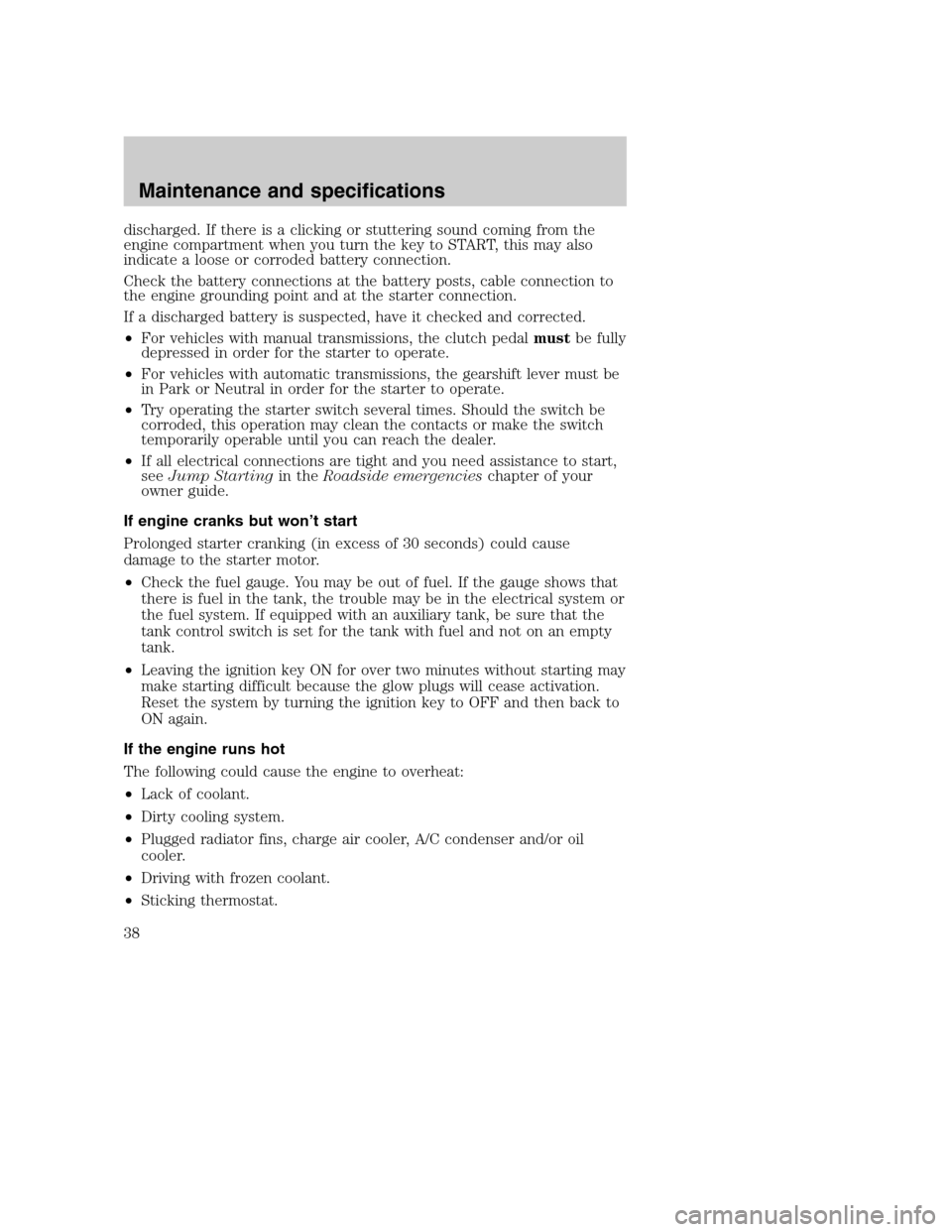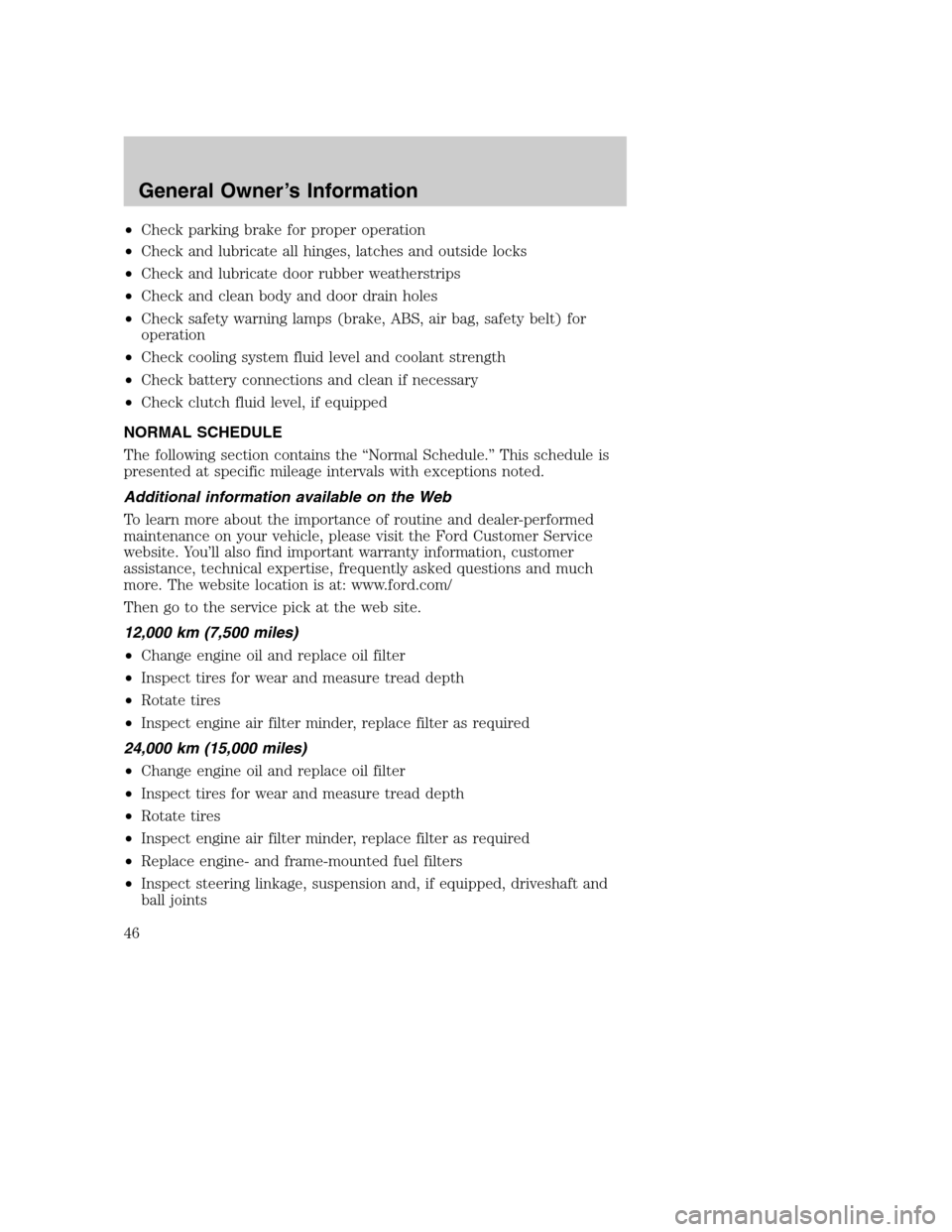Page 38 of 64

discharged. If there is a clicking or stuttering sound coming from the
engine compartment when you turn the key to START, this may also
indicate a loose or corroded battery connection.
Check the battery connections at the battery posts, cable connection to
the engine grounding point and at the starter connection.
If a discharged battery is suspected, have it checked and corrected.
•For vehicles with manual transmissions, the clutch pedalmustbe fully
depressed in order for the starter to operate.
•For vehicles with automatic transmissions, the gearshift lever must be
in Park or Neutral in order for the starter to operate.
•Try operating the starter switch several times. Should the switch be
corroded, this operation may clean the contacts or make the switch
temporarily operable until you can reach the dealer.
•If all electrical connections are tight and you need assistance to start,
seeJump Startingin theRoadside emergencieschapter of your
owner guide.
If engine cranks but won’t start
Prolonged starter cranking (in excess of 30 seconds) could cause
damage to the starter motor.
•Check the fuel gauge. You may be out of fuel. If the gauge shows that
there is fuel in the tank, the trouble may be in the electrical system or
the fuel system. If equipped with an auxiliary tank, be sure that the
tank control switch is set for the tank with fuel and not on an empty
tank.
•Leaving the ignition key ON for over two minutes without starting may
make starting difficult because the glow plugs will cease activation.
Reset the system by turning the ignition key to OFF and then back to
ON again.
If the engine runs hot
The following could cause the engine to overheat:
•Lack of coolant.
•Dirty cooling system.
•Plugged radiator fins, charge air cooler, A/C condenser and/or oil
cooler.
•Driving with frozen coolant.
•Sticking thermostat.
Maintenance and specifications
38
Page 42 of 64
In Puerto Rico and Virgin Islands, contact:
Ford Motor Company Caribbean Inc.
P.O. Box 11957, Caparra Heights Station
San Juan, PR 00922-1957
Telephone: (787) 782-5959
Fax: (787) 781-8975
E-mail: [email protected]
In Caribbean, Central America, Israel and
Sub-Saharan Africa, contact:
Ford Motor Company
Worldwide Direct Market Operations
Attention: Owner Relations
1555 Fairlane Drive, Fairlane Business Park #3
Allen Park, MI 48101 U.S.A.
Telephone: (313) 594-4857
Fax: (313) 390-0804
E-mail: [email protected]
In the Middle East and North Africa, contact:
Ford Middle East and North Africa
Customer Assistance Center
API World Tower 17
thFloor
Sheikh Zayed Road
Dubai, United Arab Emirates
Telephone: 971-4-326084
Fax: 971-4-327299
E-mail: [email protected]
General Owner’s Information
42
Page 46 of 64

•Check parking brake for proper operation
•Check and lubricate all hinges, latches and outside locks
•Check and lubricate door rubber weatherstrips
•Check and clean body and door drain holes
•Check safety warning lamps (brake, ABS, air bag, safety belt) for
operation
•Check cooling system fluid level and coolant strength
•Check battery connections and clean if necessary
•Check clutch fluid level, if equipped
NORMAL SCHEDULE
The following section contains the“Normal Schedule.”This schedule is
presented at specific mileage intervals with exceptions noted.
Additional information available on the Web
To learn more about the importance of routine and dealer-performed
maintenance on your vehicle, please visit the Ford Customer Service
website. You’ll also find important warranty information, customer
assistance, technical expertise, frequently asked questions and much
more. The website location is at: www.ford.com/
Then go to the service pick at the web site.
12,000 km (7,500 miles)
•Change engine oil and replace oil filter
•Inspect tires for wear and measure tread depth
•Rotate tires
•Inspect engine air filter minder, replace filter as required
24,000 km (15,000 miles)
•Change engine oil and replace oil filter
•Inspect tires for wear and measure tread depth
•Rotate tires
•Inspect engine air filter minder, replace filter as required
•Replace engine- and frame-mounted fuel filters
•Inspect steering linkage, suspension and, if equipped, driveshaft and
ball joints
General Owner’s Information
46